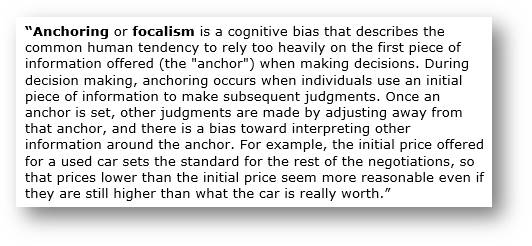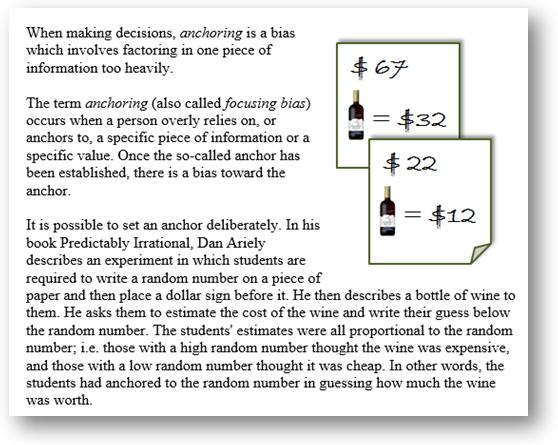Anchoring, also known as ‘focusing bias’, is the use of a reference point against which to judge value.

You hear the issue every day in a broking office, it’s when someone says “I can’t buy that because the share price is up XYZ%” or “You can’t sell that the price is down XYZ%”. An even more soft-brained development on the theme is when you find yourself saying “It’s down XYZ% so it’s cheap” or “It’s up XYZ% so it’s expensive”.
Making money in shares is all about
where the share price is going not where its been.
In that equation,
where the share price has been is pretty much irrelevant, and the fact that we don’t buy or sell a stock because it is up X percent or down X percent, because of where the share price ‘was’, is unscientific.
What you paid for a stock, what price it was in the past, in fact any reference to the share price history ignores the only relevant consideration which should be what the company is worth now or in the future.
Referencing past share prices also ignores the fact that the information/fundamentals/profitability/structure/capital base, can change. BHP five years ago was priced on an different set of facts to BHP now. A lot has changed so what relevance is that old high or old low when it relates to a different set of circumstances. It’s irrelevant.
Despite that it is common practice to reference how much a stock has moved from the lowest low or highest high and it is commonplace to take those past prices as an anchor point from which we judge the current price as being expensive or cheap based on how far it is up or down since then.
Past prices are simply a statement of where a price was.
The more important consideration is where the price is now relative to what the company is worth, because the market's appreciation of what the company was worth at some point in the past has almost certainly changed. The market's appreciation of the value of a company changes as time progresses rendering any past price effectively redundant as a reference point. As soon as the value of a company changes, which arguably it does every day, you have to move your thinking along.
Anchoring can also be exploited as a negotiating trick.
It is a technique used by flea market stall holders, putting down an anchor as quickly as possible that will then act as a standard for the rest of the negotiation. As a buyer the worst mistake is to feed into this process by asking the seller to name the first price (rookie error), you’re simply going to open the negotiation at the top price straight away. Instead a smart buyer will go in hard and early with their own anchor price point so the negotiation starts at the bottom rather than the top and it is the stall holder who has to pull it up, rather than you spending the rest of the negotiation trying to drag it down.
So if your first reference point for making a decision on a stock starts with a reference point from the past like “It’s up XYZ% from the low” you have proven yourself an amateur.
To really make a stock judgement you only need consider a more malleable reference point - like “intrinsic value”. Past prices are the most unscientific of starting points. Scientifically calculated prices, using current data, are a much better guideline.
Another amateur manifestation of anchoring is buying stocks because they have fallen a lot.
This is technically wrong anyway but also ignores the fact that the market’s assessment of the value of the company has changed markedly for the worse, so it is even more inappropriate to reference where the price (erroneously) used to be.
The other very widespread use of anchoring is when traders use their purchase price as a reference point.
“I’ll sell it if it goes up 10%” or “I’ll sell if it goes below my purchase price”. All very nice but not rational, although, in its defence, anything, even unscientific anchoring, is better than nothing when it comes to having some trading discipline.
An extension of anchoring is ‘lazy jargon’.
Saying that a stock is “cheap” or “undervalued” because it has fallen a lot. Or “expensive” or overvalued” if it’s gone up a lot. A stock can only be valued with reference to what it is worth not with reference to what the share price used to be.
The best way to avoid anchoring is to forget the past price as a reference point and simply assess ‘cheap or expensive’ on some other criteria - like PE history, or price relative to an intrinsic value calculation.
Meanwhile you can amuse yourself by listening out for anyone, you perhaps, making comments or decisions on the basis that a stock is up X% or down X%. The only thing that matters is what the market/you perceives something to be worth.
Your sole focus is whether a stock is
going up or not. Whether it’s
gone up or not. That, is irrelevant.

 You hear the issue every day in a broking office, it’s when someone says “I can’t buy that because the share price is up XYZ%” or “You can’t sell that the price is down XYZ%”. An even more soft-brained development on the theme is when you find yourself saying “It’s down XYZ% so it’s cheap” or “It’s up XYZ% so it’s expensive”.
Making money in shares is all about where the share price is going not where its been.
In that equation, where the share price has been is pretty much irrelevant, and the fact that we don’t buy or sell a stock because it is up X percent or down X percent, because of where the share price ‘was’, is unscientific.
You hear the issue every day in a broking office, it’s when someone says “I can’t buy that because the share price is up XYZ%” or “You can’t sell that the price is down XYZ%”. An even more soft-brained development on the theme is when you find yourself saying “It’s down XYZ% so it’s cheap” or “It’s up XYZ% so it’s expensive”.
Making money in shares is all about where the share price is going not where its been.
In that equation, where the share price has been is pretty much irrelevant, and the fact that we don’t buy or sell a stock because it is up X percent or down X percent, because of where the share price ‘was’, is unscientific.
